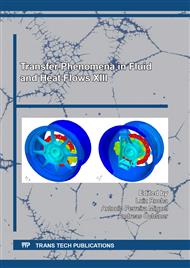[1]
A. Delano 1998, Design Analysis of the Einstein Refrigeration Cycle, Ph.D. Thesis, Georgia Institute of Technology, USA, (1998).
Google Scholar
[2]
D. Chisholm, Two-phase flow in pipelines and heat exchangers. G. Godwin, London- New York, (1983).
Google Scholar
[3]
A.H. Stenning and C. Martin, An Analytical and Experimental Study of Air-Lift Pump Performance, Journal of Engineering for Gas Turbines and Power, 90 (1968),106–112.
DOI: 10.1115/1.3609143
Google Scholar
[4]
A. Koyfman, M. Jelinek, A. Levy and I. Borde, An experimental investigation of bubble pump performance for diffusion absorption refrigeration system with organic working fluids, Applied Thermal Engineering, 23 (2003) 1881–1894.
DOI: 10.1016/s1359-4311(03)00162-5
Google Scholar
[5]
B. Gurevich 2019, Theoretical Prediction of the Mass Flow Rates in the Bubble Pump, International Journal of Thermodynamics, 22 (2019) 177-182.
DOI: 10.5541/ijot.637318
Google Scholar
[6]
N. Dammak., B. Chaouachi, S. Gabsi and M. Bourouis, Optimization of the Geometrical Parameters of a Solar Bubble Pump for Absorption-Diffusion Cooling Systems, American Journal of Engineering and Applied Sciences. 3 (2010) 693-698.
DOI: 10.3844/ajeassp.2010.693.698
Google Scholar
[7]
F. Schmid, B. Bierling and K. Spindler ,2019, Development of a solar-driven diffusion absorption chiller, Solar Energy, 177 (2019) 483-493.
DOI: 10.1016/j.solener.2018.11.040
Google Scholar
[8]
K. Lingeswaran and C. Hemalatha, Experimental Studies on Solar Powered Diffusion Absorption Refrigerator, Middle-East J. Sci., 20 (2014) 876-880.
Google Scholar
[9]
J. Freeman, A. Najjaran, R. Edwards, M. Reid, R. Hall, A. Ramos and C.N. Markides C.N., Testing and simulation of a solar diffusion-absorption refrigeration system for low-cost solar cooling in India, ISES Solar World Cong; Oct 29-Nov 2,Abu Dhabi, UAE, (2017).
DOI: 10.18086/swc.2017.28.07
Google Scholar
[10]
A. Najjaran, J. Freeman, A. Ramos A. and C.N. Markides 2019, Experimental investigation of an ammonia-water-hydrogen diffusion absorption refrigerator,Applied Energy, 256 (2019).
DOI: 10.1016/j.apenergy.2019.113899
Google Scholar
[11]
A. Zohar, M. Jelinek, A. Levy and I. Borde, 2007, The influence of diffusion absorption refrigeration cycle configuration on the performance, Applied Thermal Engineering, 27 (2007) 2213-2219.
DOI: 10.1016/j.applthermaleng.2005.07.025
Google Scholar
[12]
A. Zohar, M. Jelinek, A. Levy and I. Borde, Numerical investigation of a diffusion absorption refrigeration cycle, International Journal of Refrigeration, 28 (2005) 515-525.
DOI: 10.1016/j.ijrefrig.2004.11.003
Google Scholar
[13]
A. Zohar, M. Jelinek, A. Levy and I. Borde, The influence of the generator and bubble pump configuration on the performance of diffusion absorption refrigeration (DAR) system, International Journal of Refrigeration, 31 (2008) 962-969.
DOI: 10.1016/j.ijrefrig.2008.01.009
Google Scholar
[14]
A. Zohar, M. Jelinek, A. Levy and I. Borde, Performance of diffusion absorption refrigeration cycle with organic working fluids, International Journal of Refrigeration, 32 (2009) 1241-1246.
DOI: 10.1016/j.ijrefrig.2009.01.010
Google Scholar
[15]
R.H. Bonnecaze, W. Erskine and E.J. Greskovich, Holdup and pressure drop for two-phase slug flow in inclined pipelines, AIChE Journal, 17 (1971) 1109–1113.
DOI: 10.1002/aic.690170516
Google Scholar
[16]
I. Budihardjo and G.L. Morrison, Performance of water-in-glass evacuated tube solar water heaters, Solar Energy, 83 (2009) 49-56.
DOI: 10.1016/j.solener.2008.06.010
Google Scholar
[17]
Information on: https://ims.gov.il/en.
Google Scholar


